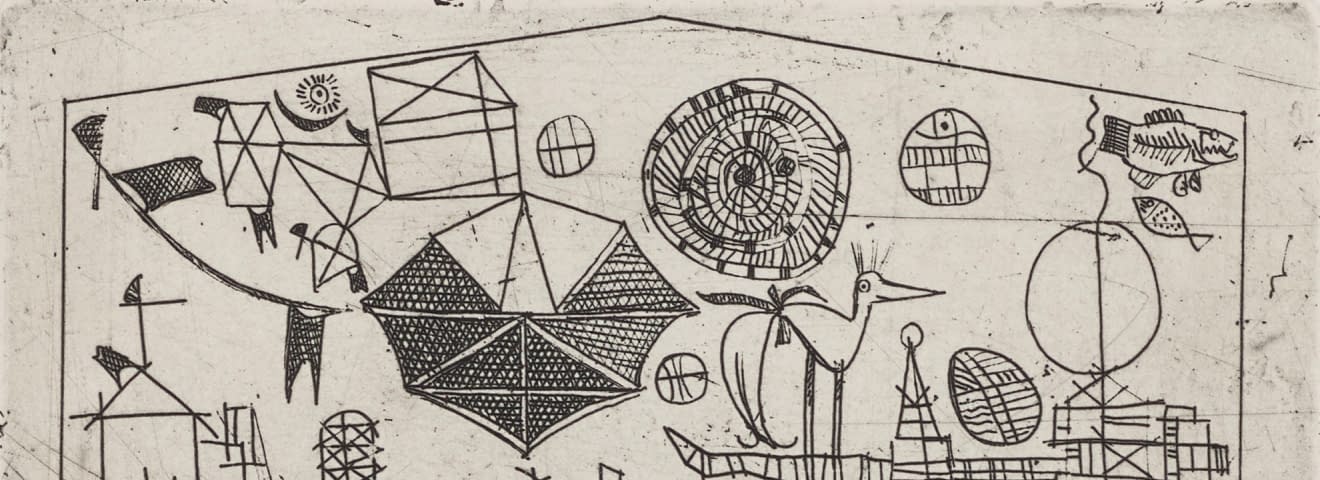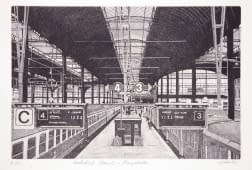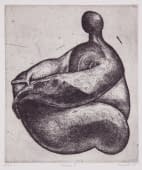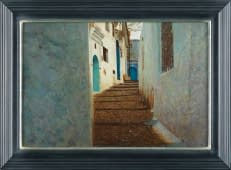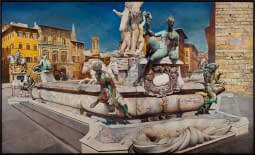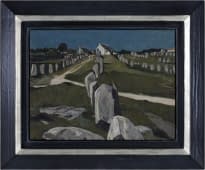Rudolf Häsler
born 29. July 1927 in Interlaken
passed away on 16. January 1999 in Sant Cugat del Vallès
Art style
About
Rudolf Häsler war ab 1947 in Interlaken als Primarlehrer tätig. Gleichzeitig nahm er Malunterricht und reiste durch Europa. 1952 gab er seinen Lehrerberuf auf und widmete sich komplett der Kunst. Reisen in die Sahara, nach Sevilla, Granada, Italien, Jugoslawien und Andalusien folgten. 1956 lernte er in Granada die Kubanerin María Dolores Soler kennen. 1957 reiste er mit ihr in ihre Heimatstadt Santiago de Cuba und heiratete sie dort. Fasziniert vom Land, entschied sich Häsler in Kuba zu bleiben und gründete dort eine Familie.
In Kuba erlebte Häsler den Höhepunkt der Kubanischen Revolution von dessen Aufbruchsstimmung er selbst begeistert war. Er wollte sich aktiv an diesem gesellschaftlichen Wandel beteiligen und schloss sich einer Künstlergruppe an, die sich insbesondere der Kunst am Bau widmete. Weiter entwickelte er ein Konzept zum Aufbau einer landesweiten Keramik-Industrie, welches von der Regierung genehmigt wurde. Er stieg zum geschäftsführenden Berater im neugegründeten Nationalinstitut für Kunstgewerbe auf und wurde 1960 zum Direktor befördert. Nach dem argentinischen Revolutionshelden Ernesto «Che» Guevara, der damalige Industrieminister, war Häsler der zweithöchste ausländische Abgeordnete im kubanischen Staat.
Der nachfolgende Wandel der Regierung hin zu einem zunehmend totalitären und militaristischen Regime war für Häsler ernüchternd. Die Geheimpolizei hatte ein Auge auf ihn geworfen und 1963 verlor er seinen Posten. Es wurden gefälschte Dokumente über ihn veröffentlicht, die ihn als ehemaliges SS-Mitglied sowie als CIA Spion der USA verleumdeten.
Häsler zog sich folglich aus dem öffentlichen Leben zurück und konzentrierte sich auf seine Karriere als freischaffender Künstler. 1969 konnte er nach einem langen, nervenaufreibenden Genehmigungsprozess mit seiner Familie aus Kuba ausreisen. Sein Leben in Kuba hielt Häsler in dem 1984 veröffentlichten Buch Kuba – Freiheit oder Terror: Ein Maler erlebt die Revolution fest.
Ab 1970 lebte Häsler in Sant Cugat del Vallès in der Provinz Barcelona. In den 1990er Jahren führten ihn Studienreisen nach Algerien, Tanger, Wien und in die Türkei.
1989 wurde ihm eine grosse Retrospektive in Barcelona gewidmet. Da viele seiner Gemälde im Zusammenhang mit seinen Reisen durch die arabische Welt entstanden, wird Häsler auch der Schule der Orientalisten zugerechnet.
Rudolf Häsler (1927, Interlaken – 1999, Sant Cugat del Vallès) became a primary school teacher in Interlaken in 1947. During that same time, he took painting lessons and travelled throughout Europe. In 1952, he gave up his teaching profession and devoted himself entirely to art. Travels to the Sahara, Seville, Granada, Italy, Yugoslavia and Andalusia followed. In 1956, he met the Cuban María Dolores Soler in Granada. In 1957, he travelled with her to her hometown of Santiago de Cuba and married her there. Fascinated by the country, Häsler decided to stay in Cuba and started a family there.
While in Cuba, Häsler experienced the climax of the Cuban Revolution, which he was rather enthusiastic about. He wanted to take an active part in this social change and joined a group of artists who devoted themselves to the concept of art in construction. He also developed a concept for the establishment of a nationwide ceramics industry, which was approved by the government. He rose to the position of executive advisor in the newly founded National Institute of Decorative Arts and was promoted to director in 1960. After Argentine revolutionary hero Ernesto "Che" Guevara, then minister of industry, Häsler was the then second-highest ranking foreign-deputy in the Cuban state.
The government's subsequent shift toward an increasingly totalitarian and militaristic regime was sobering for Häsler. The secret police had their eyes on him, and in 1963 he lost his post. Falsified documents were published about him that slandered him as a former member of the SS as well as a CIA spy for the United States.
Häsler consequently withdrew from public life and concentrated on his career as a freelance artist. In 1969, after a long, nerve-wracking approval process, he was finally able to leave Cuba with his family. Häsler documented his life in Cuba in the book: Kuba – Freiheit oder Terror: Ein Maler erlebt die Revolution, published in 1984.
From 1970 onwards, Häsler lived in Sant Cugat del Vallès in the province of Barcelona. In the 1990s, study trips took him to Algeria, Tangier, Vienna, and Turkey.
Häsler, above all, became known for his realistic, sometimes hyper realistic, paintings and drawings, which were created after his time in Cuba. These works allow comparisons with the works of Franz Gertsch, Ralph Goings, and Antonio López Garcia. In 1989, a large retrospective was dedicated to him in Barcelona. Since many of his paintings were created with a connection to his travels through the Arab states, Häsler is also considered to be a member of the school of Orientalists.
Ausstellungen (Auswahl)
2017 Rudolf Häsler, Homenatge en el 90è aniversari del seu naixement (1927-1999), Kreuzgang des Klosters von Sant Cugat del Valles, Barcelona.
2016/17 Rudolf Häsler – Retrospektive, bromer kunst, Roggwil.
2016 Die Magie des Realen, Kunsthaus Interlaken.
2010 Retrospektive, Museum Sant Cugat del Vallès, Barcelona.
In Kuba erlebte Häsler den Höhepunkt der Kubanischen Revolution von dessen Aufbruchsstimmung er selbst begeistert war. Er wollte sich aktiv an diesem gesellschaftlichen Wandel beteiligen und schloss sich einer Künstlergruppe an, die sich insbesondere der Kunst am Bau widmete. Weiter entwickelte er ein Konzept zum Aufbau einer landesweiten Keramik-Industrie, welches von der Regierung genehmigt wurde. Er stieg zum geschäftsführenden Berater im neugegründeten Nationalinstitut für Kunstgewerbe auf und wurde 1960 zum Direktor befördert. Nach dem argentinischen Revolutionshelden Ernesto «Che» Guevara, der damalige Industrieminister, war Häsler der zweithöchste ausländische Abgeordnete im kubanischen Staat.
Der nachfolgende Wandel der Regierung hin zu einem zunehmend totalitären und militaristischen Regime war für Häsler ernüchternd. Die Geheimpolizei hatte ein Auge auf ihn geworfen und 1963 verlor er seinen Posten. Es wurden gefälschte Dokumente über ihn veröffentlicht, die ihn als ehemaliges SS-Mitglied sowie als CIA Spion der USA verleumdeten.
Häsler zog sich folglich aus dem öffentlichen Leben zurück und konzentrierte sich auf seine Karriere als freischaffender Künstler. 1969 konnte er nach einem langen, nervenaufreibenden Genehmigungsprozess mit seiner Familie aus Kuba ausreisen. Sein Leben in Kuba hielt Häsler in dem 1984 veröffentlichten Buch Kuba – Freiheit oder Terror: Ein Maler erlebt die Revolution fest.
Ab 1970 lebte Häsler in Sant Cugat del Vallès in der Provinz Barcelona. In den 1990er Jahren führten ihn Studienreisen nach Algerien, Tanger, Wien und in die Türkei.
1989 wurde ihm eine grosse Retrospektive in Barcelona gewidmet. Da viele seiner Gemälde im Zusammenhang mit seinen Reisen durch die arabische Welt entstanden, wird Häsler auch der Schule der Orientalisten zugerechnet.
Rudolf Häsler (1927, Interlaken – 1999, Sant Cugat del Vallès) became a primary school teacher in Interlaken in 1947. During that same time, he took painting lessons and travelled throughout Europe. In 1952, he gave up his teaching profession and devoted himself entirely to art. Travels to the Sahara, Seville, Granada, Italy, Yugoslavia and Andalusia followed. In 1956, he met the Cuban María Dolores Soler in Granada. In 1957, he travelled with her to her hometown of Santiago de Cuba and married her there. Fascinated by the country, Häsler decided to stay in Cuba and started a family there.
While in Cuba, Häsler experienced the climax of the Cuban Revolution, which he was rather enthusiastic about. He wanted to take an active part in this social change and joined a group of artists who devoted themselves to the concept of art in construction. He also developed a concept for the establishment of a nationwide ceramics industry, which was approved by the government. He rose to the position of executive advisor in the newly founded National Institute of Decorative Arts and was promoted to director in 1960. After Argentine revolutionary hero Ernesto "Che" Guevara, then minister of industry, Häsler was the then second-highest ranking foreign-deputy in the Cuban state.
The government's subsequent shift toward an increasingly totalitarian and militaristic regime was sobering for Häsler. The secret police had their eyes on him, and in 1963 he lost his post. Falsified documents were published about him that slandered him as a former member of the SS as well as a CIA spy for the United States.
Häsler consequently withdrew from public life and concentrated on his career as a freelance artist. In 1969, after a long, nerve-wracking approval process, he was finally able to leave Cuba with his family. Häsler documented his life in Cuba in the book: Kuba – Freiheit oder Terror: Ein Maler erlebt die Revolution, published in 1984.
From 1970 onwards, Häsler lived in Sant Cugat del Vallès in the province of Barcelona. In the 1990s, study trips took him to Algeria, Tangier, Vienna, and Turkey.
Häsler, above all, became known for his realistic, sometimes hyper realistic, paintings and drawings, which were created after his time in Cuba. These works allow comparisons with the works of Franz Gertsch, Ralph Goings, and Antonio López Garcia. In 1989, a large retrospective was dedicated to him in Barcelona. Since many of his paintings were created with a connection to his travels through the Arab states, Häsler is also considered to be a member of the school of Orientalists.
Ausstellungen (Auswahl)
2017 Rudolf Häsler, Homenatge en el 90è aniversari del seu naixement (1927-1999), Kreuzgang des Klosters von Sant Cugat del Valles, Barcelona.
2016/17 Rudolf Häsler – Retrospektive, bromer kunst, Roggwil.
2016 Die Magie des Realen, Kunsthaus Interlaken.
2010 Retrospektive, Museum Sant Cugat del Vallès, Barcelona.
